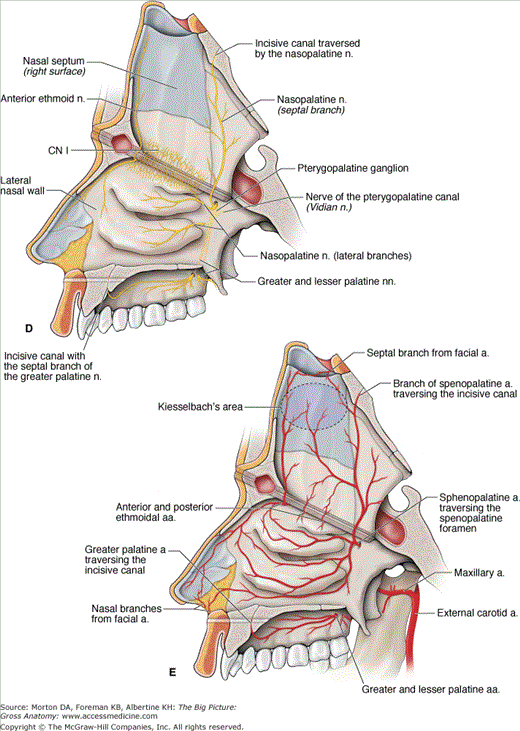Overview of the Nasal Cavity
The nasal cavity is divided into two lateral compartments separated down the middle by the nasal septum. The nasal cavity communicates anteriorly through the nostrils and posteriorly with the nasopharynx through openings called choanae. The nasal cavities and septum are lined with a mucous membrane and are richly vascularized by branches of the maxillary, facial, and ophthalmic arteries. The nasal cavity receives innervation via branches of the olfactory [cranial nerve (CN) I], ophthalmic (CN V-1), and maxillary nerves (CN V-2).
The nasal cavity is bordered by the following structures (Figure 23-1A–C):
- Roof. Formed by the nasal, frontal, sphenoid, and ethmoid bones (cribriform foramina, which transmits CN I for smell).
- Floor. Formed by the maxilla and the palatine bones. The incisive foramen transmits branches of the sphenopalatine artery and the nasopalatine nerve for general sensation from the nasal cavity and palate.
- Medial wall (nasal septum). Formed by the perpendicular plate of the ethmoid bone, the vomer bone, and the septal cartilage.
- Lateral wall. Formed by the superior, middle and inferior nasal conchae. In addition, the maxillary, sphenoid, and palatine bones contribute to the lateral wall. The lateral wall contains the following openings:
- Sphenoethmoidal recess. The space between the superior nasal concha and the sphenoid bone, with openings from the sphenoid sinus.
- Superior meatus. The space inferior to the superior nasal concha, with openings from the posterior ethmoidal air cells.
- Middle meatus. The space inferior to the middle nasal concha, with openings for the frontal sinus via the nasofrontal duct, the middle ethmoidal air cells on the ethmoidal bulla, and the anterior ethmoidal air cells and maxillary sinus in the hiatus semilunaris.
- Inferior meatus. The space inferior to the inferior nasal concha, with an opening for the nasolacrimal duct, which drains tears from the eye into the nasal cavity.
- Sphenopalatine foramen. An opening posterior to the middle nasal concha receives the nasopalatine nerve and the sphenopalatine artery from the pterygopalatine fossa into the nasal cavity.
- Sphenoethmoidal recess. The space between the superior nasal concha and the sphenoid bone, with openings from the sphenoid sinus.
 Rhinorrhea, or “runny nose,” is evident by the clear fluid that leaks out of the nostrils. A runny nose usually accompanies the common cold. Rhinorrhea usually results from overproduction of mucus resulting from conditions such as sinusitis, hay fever, and allergic reactions. However, rhinorrhea that occurs after an accident involving head trauma may indicate a basilar skull fracture, resulting in leakage of cerebrospinal fluid from the subarachnoid space through the fracture (often the ethmoid bone) into the nasal cavity and out of the nostrils.
Rhinorrhea, or “runny nose,” is evident by the clear fluid that leaks out of the nostrils. A runny nose usually accompanies the common cold. Rhinorrhea usually results from overproduction of mucus resulting from conditions such as sinusitis, hay fever, and allergic reactions. However, rhinorrhea that occurs after an accident involving head trauma may indicate a basilar skull fracture, resulting in leakage of cerebrospinal fluid from the subarachnoid space through the fracture (often the ethmoid bone) into the nasal cavity and out of the nostrils.
The nasal cavity contains the following nerves (Figure 23-1D):
Stay updated, free articles. Join our Telegram channel

Full access? Get Clinical Tree




